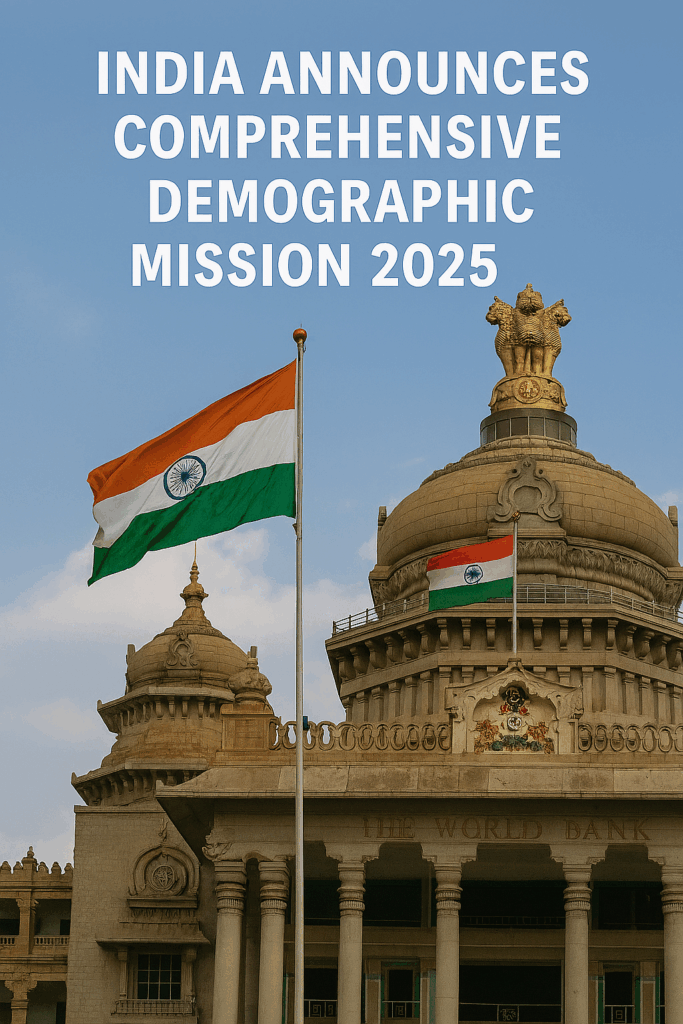
Syllabus: Demography
Context: During his Independence Day address in 2025, the Prime Minister of India declared the establishment of a high-powered Demographic Mission. This initiative is designed to tackle the issue of illegal infiltration and respond to evolving population-related challenges.
Understanding the Demographic Mission
- What is it? The Demographic Mission is a proposed, comprehensive national strategy focused on tracking, overseeing, and evaluating India’s population changes. These include trends in birth rates, death rates, migration, and population distribution, with the goal of fostering equitable growth, safeguarding national security, and ensuring sustainable development.
- Primary Objectives:
- To prevent unauthorized cross-border movement and safeguard the demographic composition of border areas.
- To cultivate a holistic view of population dynamics by incorporating social, economic, and human development metrics.
- To create a robust demographic intelligence framework that supports policymaking grounded in evidence and promotes inclusive governance.
- Key Characteristics:
- Formation of a high-level national commission to evaluate demographic trends and manage migration.
- Utilization of advanced data analytics, satellite imagery, and digitized census data for real-time population monitoring.
- Emphasis on human development indicators such as education, healthcare, skill development, aging, and mobility.
- Integration of border security considerations into broader socio-economic development plans.
Rationale for a Holistic Mission
- Population Transition: As the world’s most populous country, India is experiencing a critical shift characterized by falling birth rates, uneven regional population growth, and an increasing proportion of elderly citizens.
- Migration Patterns: Both internal and international migration are transforming labor markets and regional cultural landscapes, necessitating policies that are inclusive and respect individual rights.
- Human Capital Development: Disparities in access to education, healthcare, and skill training risk undermining the potential benefits of India’s youthful population.
- Security Concerns: Illegal immigration and altering population structures in border regions present significant risks to national security and social harmony.
- Informed Policymaking: A deep understanding of demographic trends is essential for effective distribution of resources, infrastructure development, and creating social safety nets.
Potential Implementation Hurdles
- Insufficient Data: Outdated and fragmented demographic statistics can obstruct the creation of accurate and effective policies.
- Political Sensitivity: Discussions on population issues, particularly migration and growth rates, can become politically charged and lead to social division.
- Administrative Coordination: Effective collaboration between various central ministries (e.g., Home, Health, Labour) is crucial to avoid delays and ensure seamless execution.
- Migrant Rights: Ensuring national security must be carefully balanced with upholding the constitutional rights and welfare of internal migrants.
- Aging Population: Increasing lifespans require the development of self-reliant pension and healthcare systems that do not overburden state finances.
Strategic Path Ahead
- Unified Data Platform: Combine information from the Census, National Family Health Survey (NFHS), National Population Register (NPR), and other digital systems to create a single source for planning.
- National Migration Policy: Formulate a dedicated policy that guarantees the rights of migrants while improving coordination between sending and receiving regions.
- Investment in Human Capital: Synchronize demographic strategies with enhancements in education, skill development, and healthcare systems.
- Public Engagement: Foster awareness and involve academic institutions to ensure demographic discussions are based on facts rather than political narratives.
- Strengthened Institutions: Create a National Institute for Demographic Research and Policy (NIDRP) to provide expert guidance for data-informed governance.
Conclusion
The Demographic Mission must transcend a narrow security focus to become an all-encompassing framework for population management, founded on the principles of inclusivity and long-term sustainability. Acknowledging evolving age profiles, migration trends, and human capabilities is essential to responsibly leverage India’s demographic potential. A measured, rights-oriented, and evidence-based mission will be pivotal in shaping India into a secure, just, and demographically resilient country.
